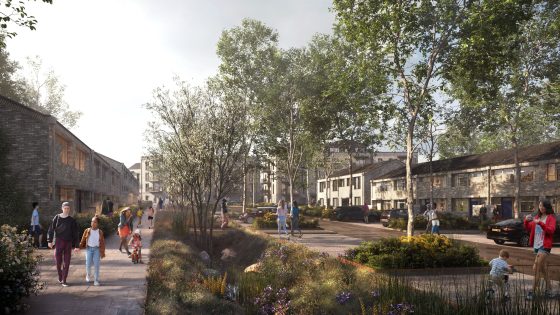At a meeting last week (16 October), Breckland Council’s planning committee refused the north London practice’s outline application to transform The Abbey neighbourhood in Thetford, citing local opposition.
Levitt Bernstein’s proposal, submitted last spring, involved the ‘comprehensive redevelopment’ of the housing estate located between the Little Ouse River and rail tracks linking Cambridge and Norwich.
More than half of the 1,087 existing homes on the site could have been demolished, along with up to 726 garages, under the plans for housing developer Bromford Flagship.
The refreshed estate would have eventually had almost 1,600 residential units along with up to 1,600m² of new flexible floorspace to be used as retail, office or community facilities. A new park and further public realm improvements were also mooted.
Planning officers had recommended the scheme be approved, but noted ‘significant local opposition’ to the scheme and warned of ‘potential social unrest during the process’.
The council received more than 190 objections along with a petition against the proposals signed by more than 1,100 people.
It also received an objection from Thetford Town Council, which objected on grounds including ‘loss of community and amenity’, saying displacement of residents ‘risks homelessness and loss of support networks’.
It also branded the plans ‘overdevelopment’ and said they were ‘unlikely to address local housing need’.
But Breckland planning officers said that there were ‘significant’ social benefits to the proposals, including ‘providing much needed dwellings to boost the council’s shortfall in housing supply’.
‘A range of tenures and housing types would be provided, with the illustrative plans depicting a well-connected, permeable, pedestrian and community-friendly estate,’ their report to councillors said.
‘The existing Abbey suffers from issues with anti-social behaviour due to the absence of properly overlooked streets, and poorly purposed green space. One of the key benefits of a redesigned estate would be an emphasis on passive surveillance and opportunities to build a stronger community through inclusive and active design.’
The officers said there were no adverse impacts that would ‘significantly and demonstrably’ outweigh the benefits of the proposals.
Despite the officers recommending the scheme, after a lengthy debate, councillors voted by a majority to refuse the application. They concluded that the ‘material planning consideration’ of uncertainty related to possible compulsory purchases of homes, and the stress resulting from this uncertainty, outweighed compliance with the development plan.
There were audible claps and cheers in the venue when the decision was announced.
Bromford Flagship chief operating officer Dave Armstrong said he was ‘disappointed’ with the committee decision but had ‘full respect’ for it.
‘We’ve spent the past five years working with local people and listening to their hopes for The Abbey,’ he added. ‘We’ve heard that change is needed, and we remain committed to working with the council and the community to make that happen.
‘The Abbey matters to us because the people who live there matter. Our aim remains the same: to improve homes, green spaces and community facilities in a way that reflects what people want. We’ll take time now to understand the reasons behind the decision, listen to what’s been said and explore how we move forward together.’
Levitt Bernstein director Simon Lea said: ‘Since 2019, we have worked closely with the residents of The Abbey in Thetford to develop a regeneration plan shaped by their wishes and aspirations.
‘Our regeneration proposal focused on improving existing homes to be more energy efficient and providing new high-quality, sustainable homes for Thetford residents, along with a new community hub and shops, safer walking and cycling routes, better parking and lighting, and improved amenity and play spaces.
‘While the council has not supported the current proposals, despite a recommendation for approval, we hope we can continue to support Bromford Flagship and the local community to help shape the future of The Abbey.’
Current site view

